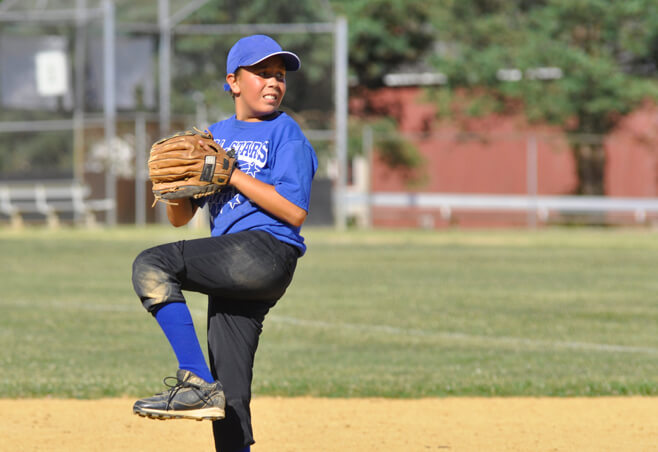Elbow growth plate injuries
Growth plate injuries of the elbow are most common in children and typically occur to those who take part in sports that involve the frequent movement of the elbow. Growth plates sit between the rounded end and middle part of the bone and made of cartilage. As your child grows, the cartilage hardens when a child’s bones stop growing, causing it to fuse into one complete bone. If your child sustains a growth plate injury, their growth can be stunted, leaving them with life-long consequences. There are both surgical and nonsurgical treatments available to get your child back to their daily activities. These treatments are chosen based on the severity of your child’s injury. Regardless of the treatment option, if the injury is treated soon enough, your child can make a full recovery.
Anatomy
Growth plates in children sit between the rounded end of the bone (epiphysis) and the long, middle part (diaphysis). This developing tissue is made up of cartilage and hardens when a child’s bones stop growing, causing it to fuse into one complete bone. For this reason, growth plate injuries only happen to children.
Because girls tend to reach skeletal maturity earlier than boys, their growth plates usually close around ages 14 to 15. Boys’ growth plates close later, at around ages 16 to 17. But before growth is complete, the growth plates are susceptible to breaks or fractures. An adult whose bones have finished growing might pull a muscle or a tendon after a fall. But in a child, that same injury could lead to an injured or fractured growth plate.
About elbow growth plate injuries
Growth plate injuries of the elbow can cause long-term complications in skeletal growth and development. For children whose bodies have not yet reached full skeletal maturity, proper treatment of an injured growth plate in the elbow is essential if your child wishes to return to his or her active lifestyle. Full skeletal maturity is not reached until ages 14 to 15 for girls and 16 to 17 for boys.
Elbow growth plate injuries are the most common elbow injury in children because the cartilage and bone in a growing child are weaker than the surrounding ligaments. There are several reasons why growth plate injuries in the elbow can occur. These reasons include:
- Strain from repetitive motion (throwing a baseball)
- A fall on an elbow or outstretched hand
- Hyperextension of the elbow joint
Children who take part in sports that use lots of elbow motions like in tennis, golf, and baseball, are most susceptible to this injury. It is important to get treated as soon as possible, as untreated growth plate injuries of the elbow can lead to life-long consequences.

Symptoms
There are several symptoms associated with growth plate injuries of the elbow, including:
- Swelling or bruising near the elbow joint
- Limited elbow movement
- Inability to move the elbow all together
- Numbness, tingling or shooting pain down the arm
- Severe pain near the elbow
Since children heal quicker than adults, it is crucial to take your child to the doctor as soon as possible. If your child has a growth plate injury that goes untreated, it can significantly affect their growth, leaving their growth permanently stunted.
Diagnosis
Your Florida Orthopaedic Institute physician will take a look at your child’s symptoms and general health to help determine the diagnosis. To confirm that your child has a growth plate injury, they will most likely order an X-ray. X-rays show dense structures in the body, such as bone. If your child has a growth plate injury, this test will show it.
Treatment
There are both surgical and nonsurgical treatments available to help your child heal. Nonsurgical treatments are recommended if the injury is not severe, meaning that the bone as not shifted or dislodged from its correct position. If the growth plate of the elbow injury is severe, then your child will most likely have to have a surgical treatment.
Nonsurgical treatment
If the growth plate injury of the elbow is not severe, your physician will prescribe immobilization of the elbow for your child. Immobilization is done with either a cast, splint or brace to prevent movement. Since children heal quickly, it will not be long before your child can return to their usual activities.
Surgical treatment
If the growth plate injury of the elbow is severe, the bone will need to be realigned, and the growth plate repaired. Surgical plates, screws or wires secure the area so that the bone can continue to grow normally. After surgery, some children may need to wear a cast through their recovery.
Recovery
Once the growth plate injury of the elbow has healed, some children might need physical therapy to help regain strength and flexibility in the elbow joint.
Most children treated for growth plate injuries do not have any long-term complications. But frequent follow-ups with your Florida Orthopaedic Institute physician (for up to a year or longer) are important to ensure your child’s bones are healing and continuing to grow normally.
Videos
Related specialties
- Arthroscopic Debridement of the Elbow
- Aspiration of the Olecranon Bursa
- Cubital Tunnel Syndrome
- Elbow Bursitis
- Elbow Injuries & Inner Elbow Pain in Throwing Athletes
- Golfer's Elbow
- Hyperextension Injury of the Elbow
- Little Leaguer's Elbow (Medial Apophysitis)
- Olecranon Stress Fractures
- Radial Tunnel Syndrome
- Tennis Elbow Treatment
- Tricep Pain & Tendonitis
- UCL (Ulnar Collateral Ligament) Injuries
- Valgus Extension Overload
